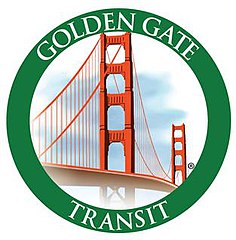Golden Gate Transit
 |
|
 |
|
| Parent | Golden Gate Bridge, Highway and Transportation District |
|---|---|
| Founded | January 1, 1972 |
| Headquarters | 1011 Andersen Drive San Rafael, CA |
| Service area | San Francisco Bay Area (San Francisco, Marin, Sonoma, Alameda, and Contra Costa Counties) |
| Service type | bus service |
| Routes | 26 |
| Stops | 720 |
| Hubs | San Rafael Transit Center, Santa Rosa Transit Mall |
| Stations | Copeland Street Transit Mall (Petaluma), Donahue & Terners (Marin City), El Cerrito del Norte BART, Redwood & Grant (Novato), San Anselmo Hub |
| Fleet | 160 buses |
| Daily ridership | 11,755 per weekday (FY 2016) |
| Website | goldengatetransit.org |
Golden Gate Transit (GGT) is a public transportation system serving the North Bay region of the San Francisco Bay Area in California, United States. It primarily serves Marin and Sonoma counties, and also provides limited service to San Francisco and Contra Costa County.
Golden Gate Transit is one of three transportation systems owned and operated by the Golden Gate Bridge, Highway and Transportation District; the others are the Golden Gate Bridge and Golden Gate Ferry, both of which connect San Francisco and Marin County. Funding for cross-bridge "Transbay" bus service is partially subsidized by Golden Gate Bridge tolls in addition to traditional federal and state sources. GGT provides some bus service within Marin County under contract with Marin Transit.
Golden Gate Transit is constituted as a special district under California State Law, as evidenced by Assembly Bill 584, creating the Golden Gate Bridge, Highway and Transportation District (District). The District consists of 19 directors from 6 Northern California counties:
Golden Gate Transit has alleviated congestion on the Golden Gate Bridge and along the Golden Gate Corridor since 1972. A history of service is listed below.
The Golden Gate Bridge, operated by the Golden Gate Bridge and Highway District, saw a huge increase in the number of crossings every year, from just 3.3 million in its opening year (1937) to 28.3 million 30 years later (1967). With average annual increase in traffic of 70% over 30 years, the Bridge was close to reaching its saturation point. As congestion mounted, several studies were undertaken to identify alternate means of travel between Marin County and San Francisco. The "San Francisco-Marin Crossings" report of May 1967 looked at the possibility of building another bridge. The District also considered adding a second deck to the Bridge. Several traffic-relief measures were implemented during the 1960s, including reversible lanes, which were inaugurated on the Bridge in 1963, and a first-of-its kind one-way toll collection system in 1968 that has since been used on other bridges throughout the world.
...
Wikipedia
